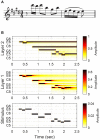A Dynamical Model of Pitch Memory Provides an Improved Basis for Implied Harmony Estimation
- PMID: 28522983
- PMCID: PMC5415596
- DOI: 10.3389/fpsyg.2017.00666
A Dynamical Model of Pitch Memory Provides an Improved Basis for Implied Harmony Estimation
Abstract
Tonal melody can imply vertical harmony through a sequence of tones. Current methods for automatic chord estimation commonly use chroma-based features extracted from audio signals. However, the implied harmony of unaccompanied melodies can be difficult to estimate on the basis of chroma content in the presence of frequent nonchord tones. Here we present a novel approach to automatic chord estimation based on the human perception of pitch sequences. We use cohesion and inhibition between pitches in auditory short-term memory to differentiate chord tones and nonchord tones in tonal melodies. We model short-term pitch memory as a gradient frequency neural network, which is a biologically realistic model of auditory neural processing. The model is a dynamical system consisting of a network of tonotopically tuned nonlinear oscillators driven by audio signals. The oscillators interact with each other through nonlinear resonance and lateral inhibition, and the pattern of oscillatory traces emerging from the interactions is taken as a measure of pitch salience. We test the model with a collection of unaccompanied tonal melodies to evaluate it as a feature extractor for chord estimation. We show that chord tones are selectively enhanced in the response of the model, thereby increasing the accuracy of implied harmony estimation. We also find that, like other existing features for chord estimation, the performance of the model can be improved by using segmented input signals. We discuss possible ways to expand the present model into a full chord estimation system within the dynamical systems framework.
Keywords: automatic chord estimation; dynamical system; gradient frequency neural network; implied harmony; neural oscillation; pitch memory; tonal melody.
Figures






Similar articles
-
Development of the adaptive music perception test.Ear Hear. 2015 Mar-Apr;36(2):217-28. doi: 10.1097/AUD.0000000000000112. Ear Hear. 2015. PMID: 25350404
-
Familiar Tonal Context Improves Accuracy of Pitch Interval Perception.Front Psychol. 2017 Oct 9;8:1753. doi: 10.3389/fpsyg.2017.01753. eCollection 2017. Front Psychol. 2017. PMID: 29062295 Free PMC article.
-
RL-Chord: CLSTM-Based Melody Harmonization Using Deep Reinforcement Learning.IEEE Trans Neural Netw Learn Syst. 2024 Aug;35(8):11128-11141. doi: 10.1109/TNNLS.2023.3248793. Epub 2024 Aug 5. IEEE Trans Neural Netw Learn Syst. 2024. PMID: 37028328
-
Neurobiological foundations for the theory of harmony in western tonal music.Ann N Y Acad Sci. 2001 Jun;930:92-116. doi: 10.1111/j.1749-6632.2001.tb05727.x. Ann N Y Acad Sci. 2001. PMID: 11458869 Review.
-
Young children's harmonic perception.Ann N Y Acad Sci. 2003 Nov;999:477-84. doi: 10.1196/annals.1284.058. Ann N Y Acad Sci. 2003. PMID: 14681171 Review.
Cited by
-
Neural Entrainment to Musical Pulse in Naturalistic Music Is Preserved in Aging: Implications for Music-Based Interventions.Brain Sci. 2022 Dec 7;12(12):1676. doi: 10.3390/brainsci12121676. Brain Sci. 2022. PMID: 36552136 Free PMC article.
-
Multifrequency Hebbian plasticity in coupled neural oscillators.Biol Cybern. 2021 Feb;115(1):43-57. doi: 10.1007/s00422-020-00854-6. Epub 2021 Jan 5. Biol Cybern. 2021. PMID: 33399947
-
Musical neurodynamics.Nat Rev Neurosci. 2025 May;26(5):293-307. doi: 10.1038/s41583-025-00915-4. Epub 2025 Mar 18. Nat Rev Neurosci. 2025. PMID: 40102614 Review.
References
-
- Apel W. (1969). The Harvard Dictionary of Music, 2nd Edn. Cambridge, MA: Belknap Press.
-
- Bartsch M. A., Wakefield G. H. (2001). To catch a chorus: using chroma-based representations for audio thumbnailing, in Proceedings of the 2001 IEEE Workshop on the Applications of Signal Processing to Audio and Acoustics (New Paltz, NY: IEEE; ), 15–18.
-
- Bello J. P., Pickens J. (2005). A robust mid-level representation for harmonic content in music signals, in Proceedings of the 6th International Conference on Music Information Retrieval (London: Queen Mary, University of London; ), 304–311.
-
- Bharucha J. J. (1984). Anchoring effects in music: the resolution of dissonance. Cogn. Psychol. 16, 485–518. 10.1016/0010-0285(84)90018-5 - DOI
-
- Bharucha J. J. (1996). Melodic anchoring. Music Percept. 13, 383–400. 10.2307/40286176 - DOI
LinkOut - more resources
Full Text Sources
Other Literature Sources

